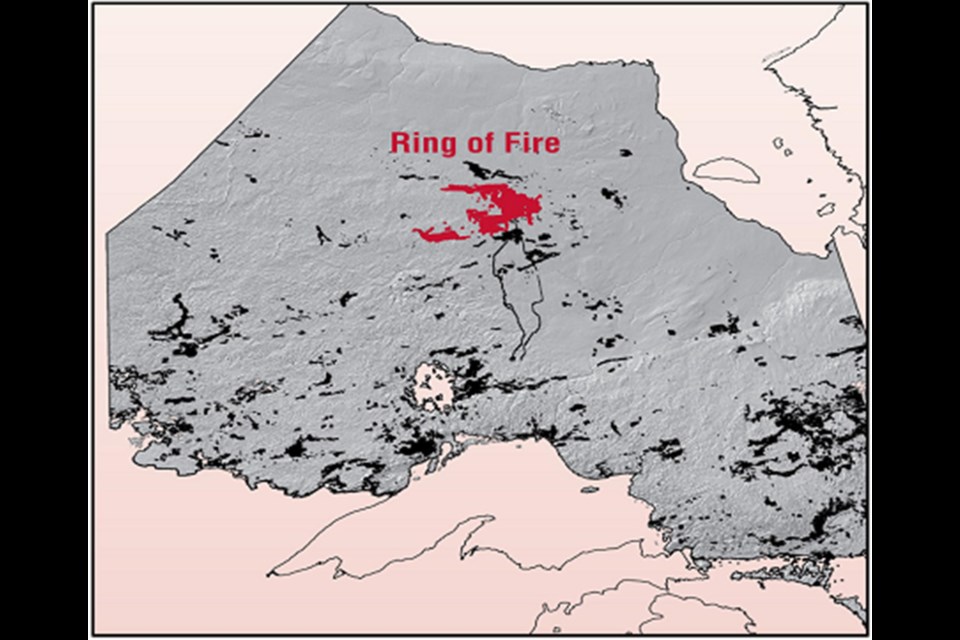The Ring of Fire, the large tract of land in Northern Ontario, south of James Bay, west of Timmins and north of Thunder Bay, constitutes a 5,000 square kilometres swath of muskeg, that remains a potential for vast mining activity, but has been agonizingly slow getting to the operational stage.
The Ontario government renewed its commitment to the Ring of Fire development in its September Speech from the Throne. The commitment was also contained in the Ontario Budget.
“In Ontario’s 2016 budget, the government reaffirmed its $1 billion commitment to developing strategic transportation infrastructure to the Ring of Fire,” said Julia Bennett, Communications spokesperson for the Ministry of Northern Development and Mines.
“Our government will make decisions which balance the need for growth in the Ring of Fire region and providing the necessary supports in the surrounding First Nation communities,” she added.
The approach of the Wynne government and that of her predecessor, Dalton McGuinty is that such a great economic potential has to be handled right.
“This development is a complex undertaking and we are taking the time to get it right,” stated Bennett.
Progress is taking place slowly - but steadily.
“A technical review of industrial infrastructure proposals by the ROF Infrastructure Development Corporation is currently underway,” she noted.
“The review will provide technical information on the proposals put forward by proponents in the Ring of Fire and provide a common basis of understanding as discussions with key partners on transportation infrastructure advance,” Bennett added.
Almost two years ago Michael Gravelle, the Ontario Minister of Northern Affairs and Mining and his then counter part, Greg Rickford, the federal minister responsible for the Ring of Fire, announced at PDAC 2015 funding for study into transportation and infrastructure corridors, that was to be undertaken by the Matawa First Nations communities.
“The ministry is currently reviewing the results of the Regional Community Service Corridor study submitted to Ontario by 4 of the remote Matawa Council First Nations communities, said Bennett.
“The government will collaborate and work with the First Nations to determine next steps,” she added.
Noront’s proposal for development of its Eagle’s Nest nickel mine project is the most advanced of the possible future mining developments.
“There is a coordinated federal-provincial environmental assessment for Noront’s Eagles Nest nickel mine project and an east-west transportation corridor,” Bennett pointed out.
“The federal government issued its Environmental Impact Study Guidelines in January 2012,” Bennett stated.
“In June 2015, the provincial Minister of the Environment and Climate Change approved the terms of reference for Noront’s environmental assessment for its Eagle’s Nest Project, with amendments,” she explained.
“The amendments reflect the unique environmental and social context of the region and require a review of other transportation route options,” she said.
According to Bennett, the approved terms of reference is the first step in the provincial environmental assessment process. It allows Noront to proceed with preparing its assessment. An environmental assessment must be completed before a decision is made on whether to approve the undertaking.
Allan Coutts CEO of Noront, while addressing the Canadian Mining Expo in June, 2016, in Timmins, said his company is a mining company and not a road building company.
“The province of Ontario should build a road – not a super highway, but a low-cost, two lane road that would get mining trucks to and from the Ring of Fire,” Coutts told the audience.
Coutts said Ontario and federal government infrastructure money is better spent on a modest, east-west road rather than a potentially expensive, $2-billion north-south rail line proposed by KWG a competing Ring of Fire company, but one in which Noront also has a heavy interest.
KWG announced in April, 2016 they were going to build a rail line with the use of a Chinese Railway Engineering Company, but has made no further announcements since.
Ottawa and Ontario want to make major investments in infrastructure to Ontario’s most remote region and assist First Nations communities beset with social issues such as rising youth suicides. These isolated First Nations are accessible only by air.
The Ring of Fire contains mineral deposits in a massive area located about 500 kilometres northeast of Thunder Bay and approximately 700 km west of Timmins, Ontario.
Ontario has pledged $1-billion toward Ring of Fire infrastructure and has asked Ottawa for matching funds.
Recent low prices for chromate have dampened enthusiasm for moving ahead on some of the Ring of Fire projects; however, this wouldn't prevent Noront from moving ahead with its plan to start its nickel and silver mining should a road be built.
